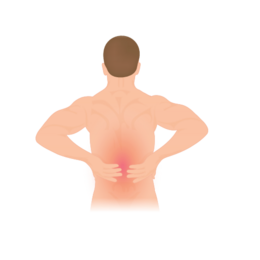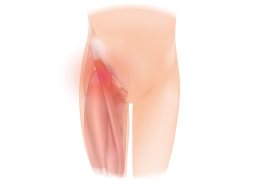Hip Spine Syndrome
Definition[edit | edit source]
Hip-spine syndrome was first described by Offerski and Macnab in 1983 [1]and refers to concurrent hip osteoarthritis and lumbar spine degenerative disease in elderly patients. It was explained that the patient has combined LBP and groin pain. Recently,
It has expanded and includes other hip pathologies such as femoral-acetabular impingement, labral tear, hip dysplasia, and other lumbar pathologies such as facet arthropathy, lumbar spinal stenosis, and sacroiliac joint pain. There is a high prevalence of lumbar and lumbosacral pathologies combined with hip abductor tendon disorders.[2]
Classification[edit | edit source]
Hip-spine syndrome is classified into four categories:[3]
- Simple: The primary source of symptoms may be attributed to either the hip or spine. That means either a patient who has lumbar pathology refers pain to the inguinal region, but the source is the spine and no hip pathology, or a patient who has hip pathology refers pain to the lumbar spine without any problem at the lumbar spine.
- Secondary: Hip and spine pain are interdependent such that the symptoms of one are secondary to a deformity or pathology of the other. This means that hip pathology causes spinal pathology or vice versa.
- Complex: There are concurrent pathological changes in both the hip and spine, with no clear primary source of pain.
- Misdiagnosis: Same Pain pattern but not related to the hip or lumber regions such as visceral problem which refers pain to spine and hip regions.
Clinical Presentation[edit | edit source]
The patient may be presented with combined symptoms that may be overlapped, such as:
- Low Back pain (LBP).
- Groin pain.
- Pain in the buttocks.
- Pain down the lower limb. [4]
Diagnostic Procedures[edit | edit source]
Although it is hard to differentiate the cause of the symptoms either the spine or hip pathology, it is necessary to examine both to classify the type of Hip-Spine Syndrome, including: [4]
- Hip-examination.
- Spine examination includes a straight leg raise test, femoral nerve tension test, reflexes in lower extremities, and gait assessment.
- If the clinical examination remains inconclusive, an ultrasound or fluoroscopic-guided intra-articular hip injection is used.
- Hip Arthroscopy.
Management / Interventions[edit | edit source]
The literature still needs to fill the gaps in research on this syndrome. It is important to identify whether the patient is a hip user or a spine user to go through the proper treatment procedure for this condition. The possible treatments are: [4]
- Physical therapy: includes decreasing the pain, improving hip and spine range of motion, strengthening core muscles, and improving the surrounding muscles' flexibility.
- Some cases need to undergo hip arthroplasty or decompression surgery for the lumbar spine.
References[edit | edit source]
- ↑ Offierski CM, MacNab I. Hip-spine syndrome. Spine. 1983 Apr 1;8(3):316-21
- ↑ Maldonado DR, Youssefzadeh KA, Wydra F, Sherman B, Gerhardt MB. High prevalence of lumbosacral pathology in patients with greater trochanteric pain syndrome. Arthroscopy: The Journal of Arthroscopic & Related Surgery. 2022 Apr 1;38(4):1189-92.
- ↑ Dutton R. A Review of Hip-Spine Syndrome. Current Physical Medicine and Rehabilitation Reports. 2019 Sep 15;7:264-74.
- ↑ 4.0 4.1 4.2 Vaswani R, White AE, Feingold J, Ranawat AS. Hip–Spine Syndrome in the Nonarthritic Patient. Arthroscopy: The Journal of Arthroscopic & Related Surgery. 2022 Oct 1;38(10):2930-8.








